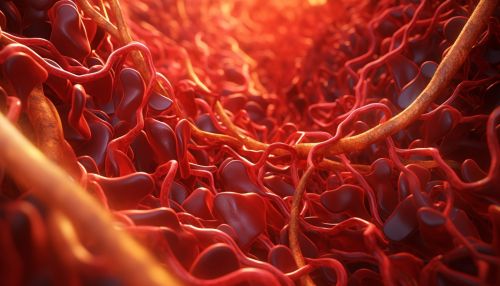Arteries
Anatomy and Structure
The human body is a complex network of interconnected systems, one of which is the circulatory system. Arteries are a vital component of this system, responsible for transporting oxygenated blood from the heart to the rest of the body. They are essentially muscular tubes lined by smooth tissue and have a layer of muscle and elastic tissue around them, which makes them strong, flexible, and able to withstand the pressure of the blood being pumped by the heart.


An artery's structure can be divided into three layers: the tunica intima, tunica media, and tunica adventitia. The tunica intima, the innermost layer, is composed of a single layer of simple squamous endothelial cells glued by a polysaccharide intercellular matrix, surrounded by a layer of subendothelial connective tissue interlaced with a number of circularly arranged elastic bands called the internal elastic lamina.
The tunica media, the middle layer, is primarily composed of circularly arranged elastic fiber, connective tissue, and smooth muscle cells. This layer is the thickest layer in arteries, and is responsible for maintaining blood pressure and continuous blood circulation through the artery.
The tunica adventitia, the outermost layer, is mostly composed of connective tissue. It contains nerves that supply the artery, and in larger arteries, small blood vessels called vasa vasorum. The vasa vasorum nourish the outer part of the artery wall. Larger arteries also contain more elastic fibers, which allow them to stretch in response to each pulse, and then recoil when the heart is refilling with blood.
Types of Arteries
Arteries can be classified into three types based on their size and function: large elastic arteries, medium muscular arteries, and small arteries and arterioles.
Large elastic arteries, also known as conducting arteries, include the aorta and its major branches. They have more elastic fibers and less smooth muscle and are able to withstand and smooth out the pressure fluctuations due to the heart's pumping.
Medium muscular arteries, also known as distributing arteries, distribute blood to specific organs and parts of the body. They have a larger amount of smooth muscle, which allows for greater vasoconstriction and vasodilation to regulate the blood flow to different parts of the body.
Small arteries and arterioles, the smallest of the arteries, lead to the capillary beds. They play a key role in regulating blood flow into the capillaries and are primary regulators of blood pressure.
Function
The primary function of arteries is to transport oxygenated blood from the heart to the tissues of the body. However, there are exceptions to this, notably the pulmonary and umbilical arteries, which carry deoxygenated blood to the lungs and placenta, respectively.
Arteries also play a key role in maintaining the pH and temperature of the body. The arterial blood's pH is maintained at around 7.4, and the temperature is maintained at around 37 degrees Celsius. Any significant changes in these parameters can lead to harmful effects on the body's organs.
Diseases and Disorders
Arterial diseases are mainly due to the blockage or weakening of the arteries. The most common arterial diseases include atherosclerosis, arteritis, and aneurysms.
Atherosclerosis is a condition where the arteries become narrow and hard due to the buildup of plaque, a substance made up of fat, cholesterol, calcium, and other substances found in the blood. This can lead to serious problems, including heart attack, stroke, or even death.
Arteritis, also known as vasculitis, is the inflammation of the arteries. It can occur as a result of infection, injury, or autoimmune disease. Symptoms can include pain, redness, and swelling in the affected area.
Aneurysms are bulges or swellings in the arteries, caused by a weakness in the arterial wall. Aneurysms can burst and cause life-threatening internal bleeding.
Prevention and Treatment
Prevention of arterial diseases involves a healthy lifestyle, including regular exercise, a balanced diet, and avoiding smoking and excessive alcohol consumption. Regular check-ups can also help detect any early signs of arterial diseases.
Treatment of arterial diseases involves medication, lifestyle changes, and in severe cases, surgery. Medications can help lower blood pressure, reduce cholesterol levels, and prevent blood clots. In some cases, surgical procedures may be required to remove or bypass a blocked artery, or to repair a damaged or weakened artery.
